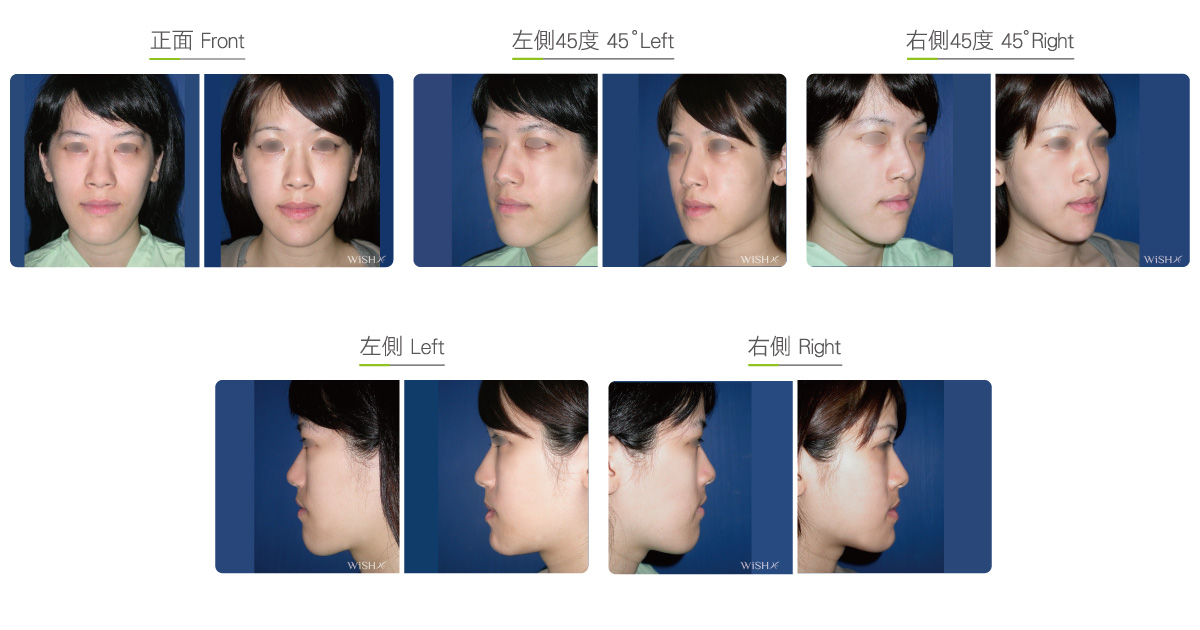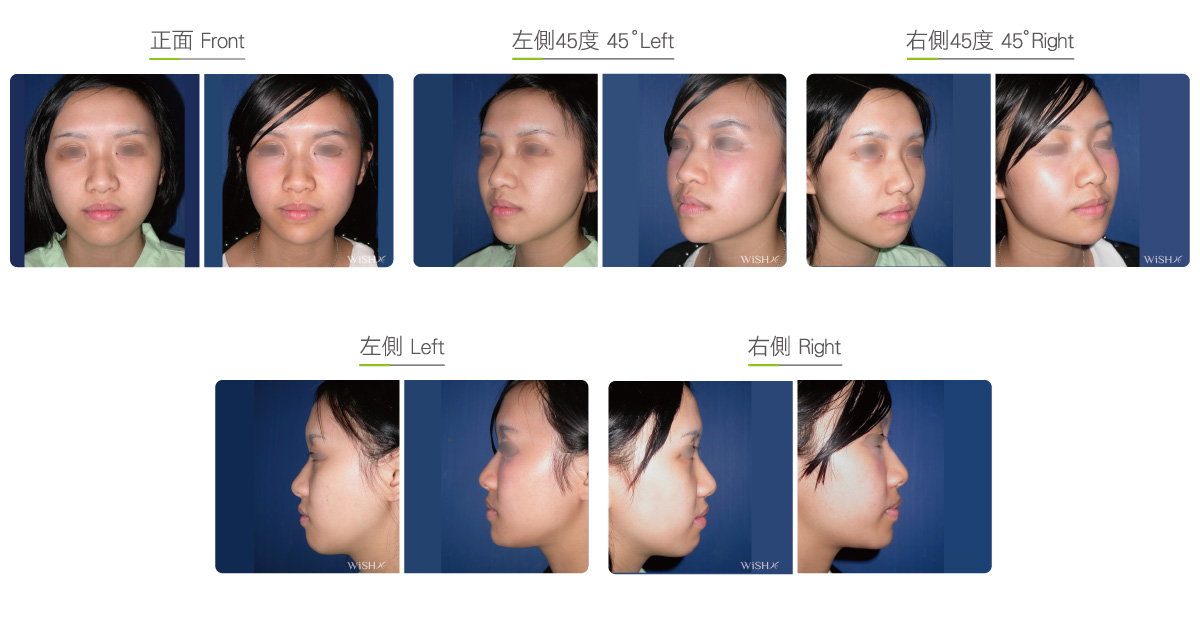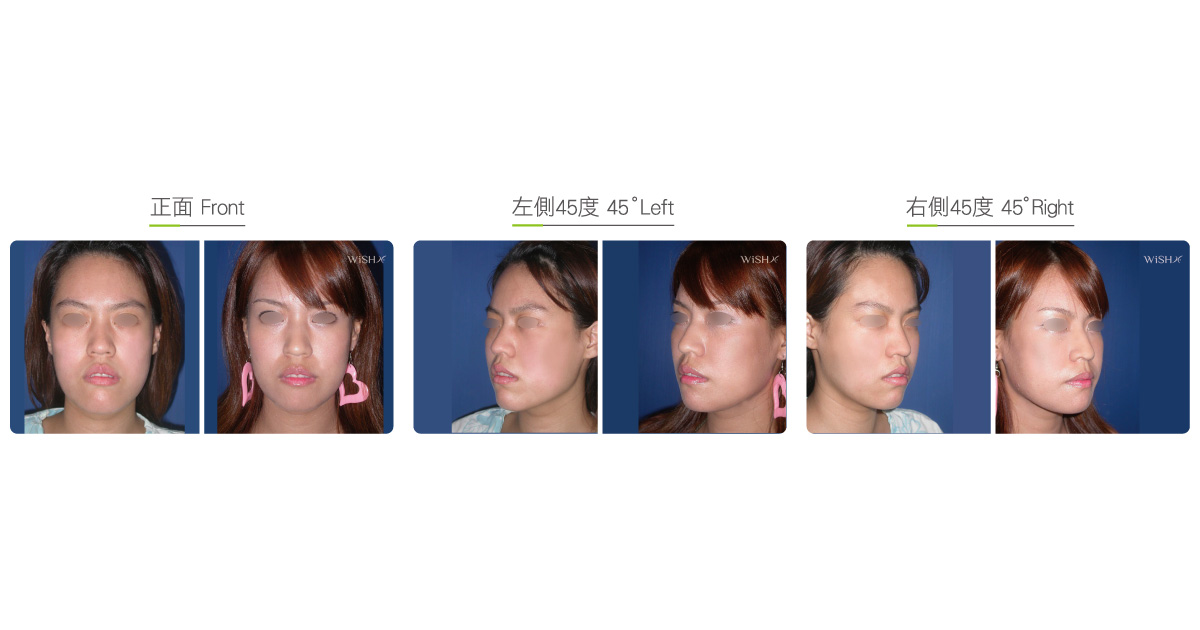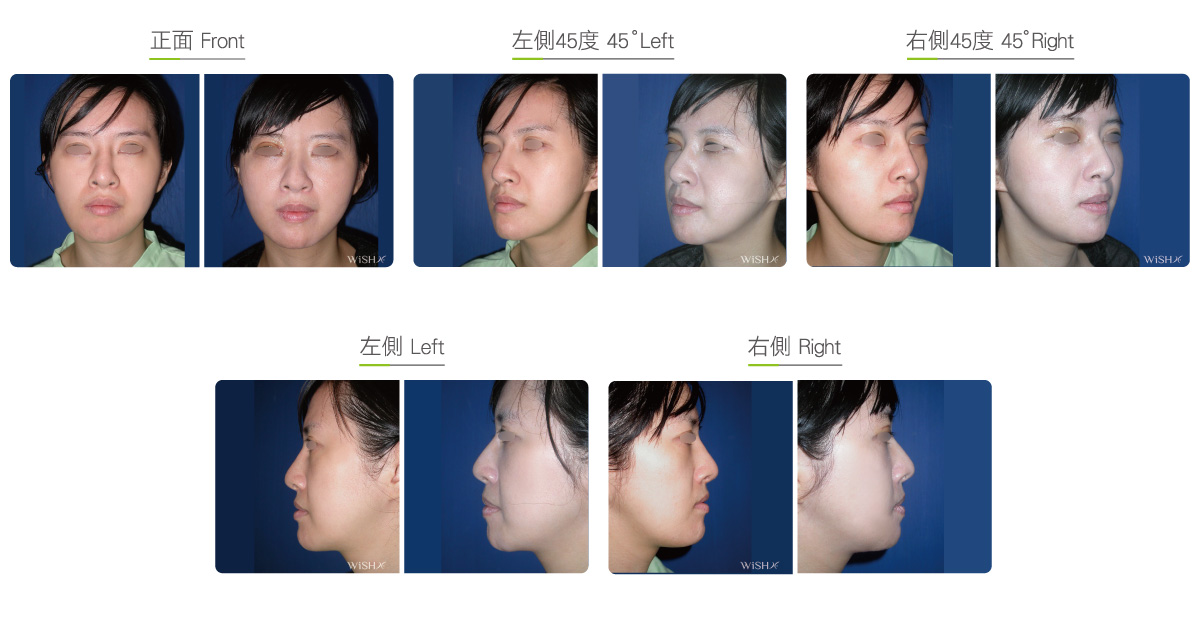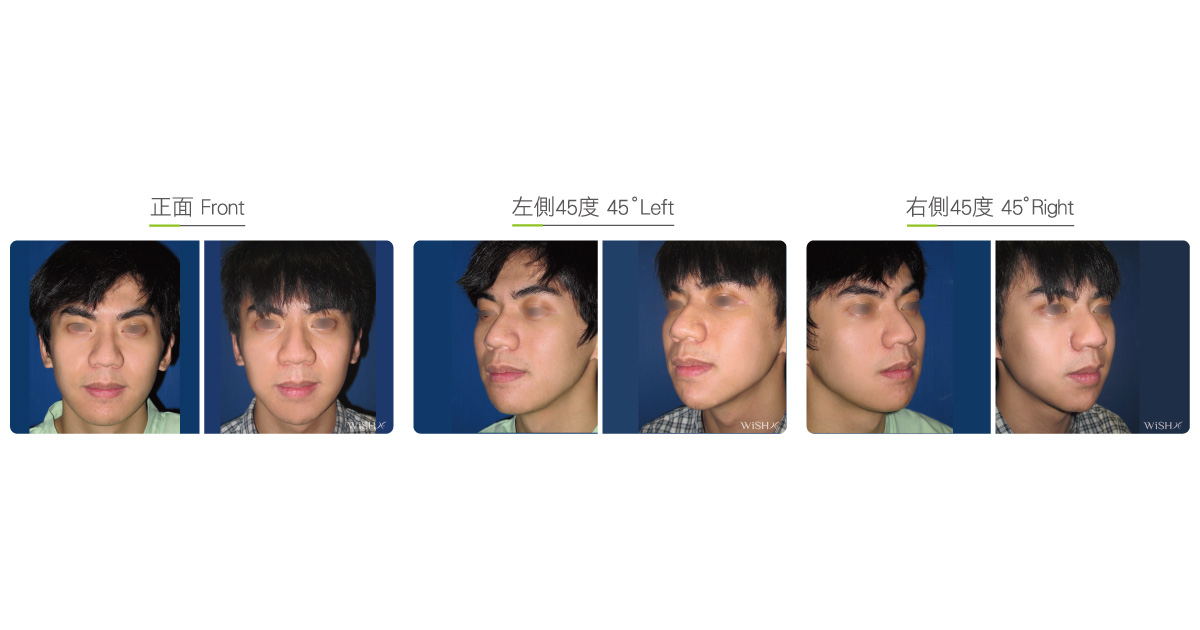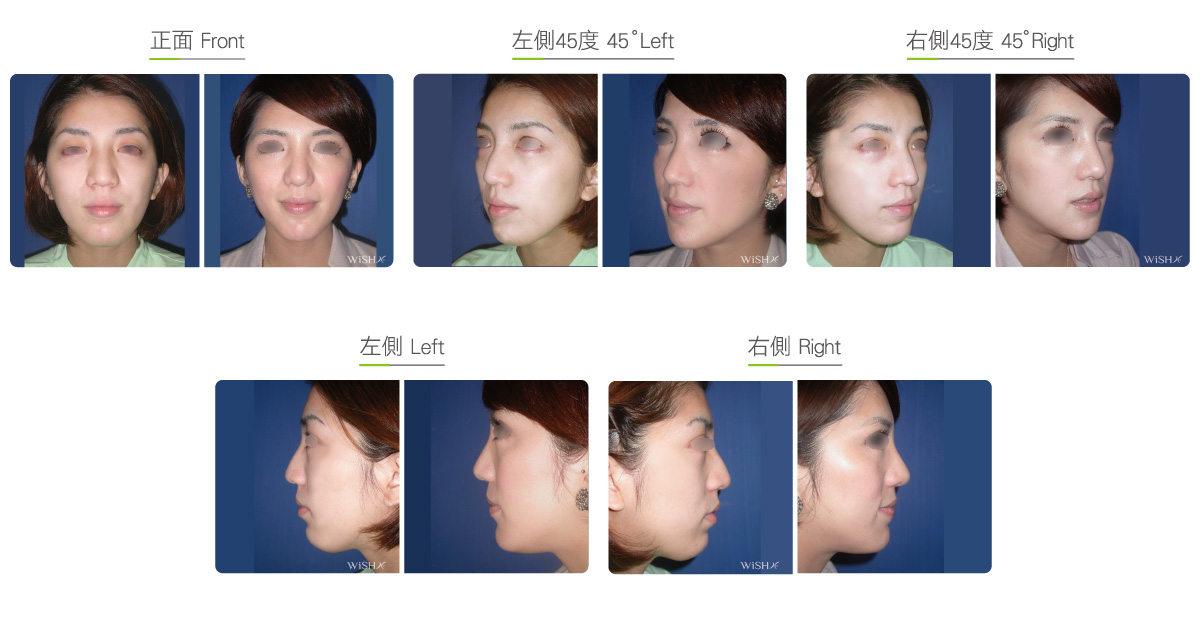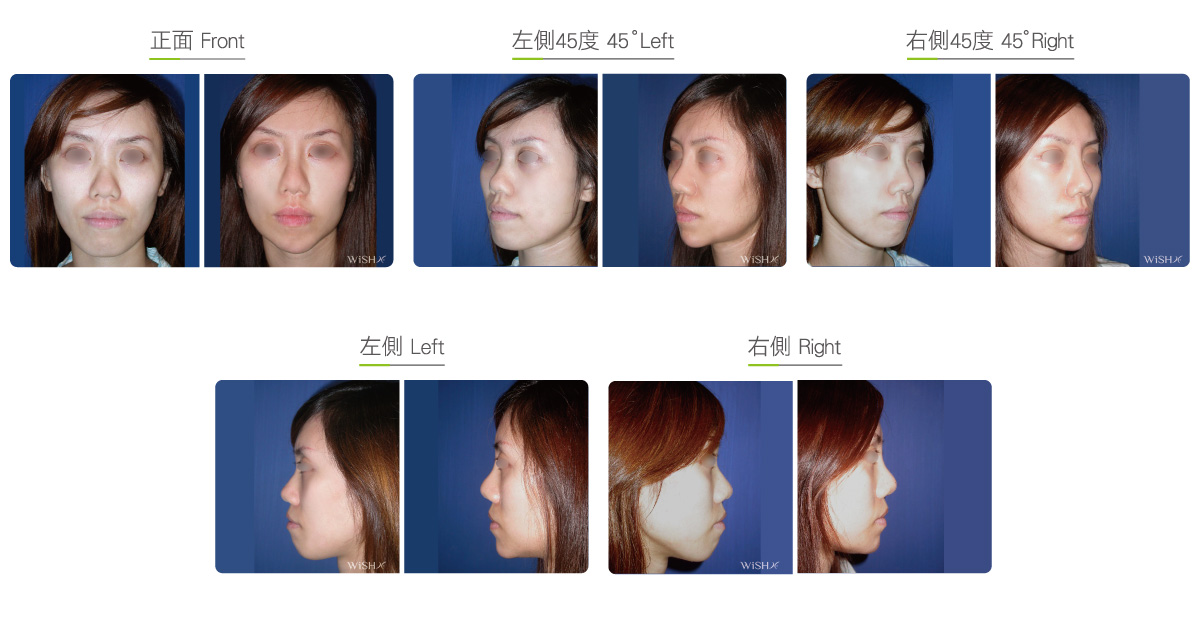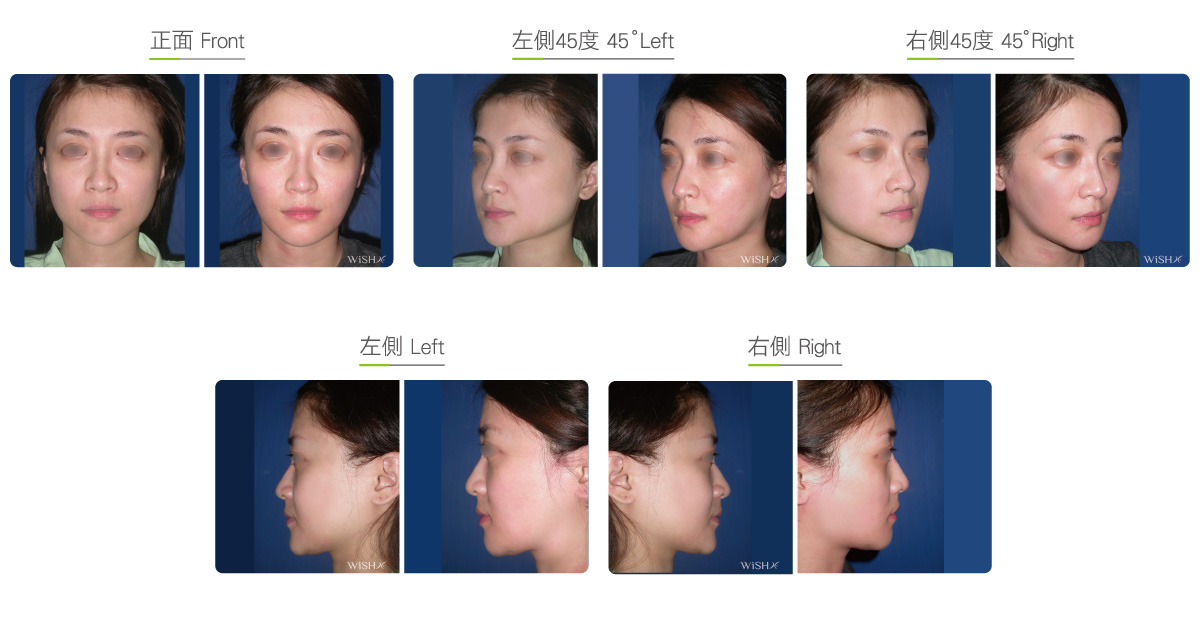V-Line Reductive Genioplasty
This is a novel chinbone reduction surgery and has become popular in recent years; it is also called “pointed face” or “awl face” chinbone reduction. Because this surgery can effectively make the chin pointier, smaller, shorter, and sharper to create a visually refreshing and slim contour, it has already become a popular procedure among the next-generation patients. This surgery overthrows the traditional sense of beauty that the chin has to be smooth and round, like a “U” shape, but consciously reconstructs a pointed and slightly upturned chin by bone cutting to make the lower face a “V-line” contour. However, surgeons will have to evaluate the mandible condition to determine whether simple chinbone reduction is appropriate to get a V-shaped chin. Those with a wide or square-shaped face due to obvious mandible splaying will simultaneously undergo V-line reductive genioplasty plus mandible reduction to achieve the expected result of a pointed face.
The procedural range is based on the thickness and width of the chin and is usually from the bottom of the chin to the posterolateral body of the mandible. The cutting line is directed from the front (chin) to the back (mandible), which is opposite the direction of the angle-splitting osteotomy of the mandible; the latter is from the back to the front and stops next to the side of the chin. Bone resection along the front-to-back direction is away from the mental nerve and effectively obtains the V-shaped result on both sides of the chin. If patients also need to undergo long curved mandibular contouring surgery including reductive genioplasty, they can obtain a big “V”-shaped contour of the lower face. Based on the type of chin and requirements of patients, the procedure has two options:
Cortical osteotomy (cortical resection)
The goal of this procedure is to mainly reduce the width of the chin and thickness of the chinbone, making the chin look narrower and slightly V-shaped. The surgery is suitable for patients who have mild to moderate chinbone hypertrophy or who pursue a natural, small rounded, or slightly pointed chin but not a real “awl face.” During the procedure, Dr. Chuang will cut open a 4–5-cm incision in the lower gum, subperiosteally detach the skin from the bones, and then, along the sagittal plane, bilaterally resect and grind off the outer cortical bone of the chin, which is outward expanded or thickened; the area and amount of bone removal should be enough for a “V”-shaped look. This procedure does not need bone screws or plate fixation; if necessary, Dr. Chuang will perform combined transverse reduction osteotomy to shorten the chin or anterior sliding osteotomy to achieve the significant pointed and upturned result.
The advantages of this surgery are as follows: the tissue injury caused by bone resection is small; recovery is fast; and complications, such as mandibular nerve numbness or chin skin loosening, are very rare. The disadvantage is that the result of a pointed face is limited or unobvious. The main goal of this surgery is reducing the chin visual area in the front view and reconstructing a slightly pointed chin.
“T”-shaped osteotomy (body resection)
This is a complex “V”-shaped reduction; the sculptural result of a pointed chin is more obvious than that achieved with cortical resection. During the procedure, Dr. Chuang will make a 5–6-cm incision in the front lower gum; after the subperiosteal detachment of the chin skin and bone, Dr. Chuang will transversally cut through and remove part of the chinbone body (segmental resection) to shorten its length and then longitudinally cut off a vertical fragment of the distal piece (vertical resection) to effectively reduce the width of the chin. Because this surgery includes both transverse and vertical resections of the chinbone, it ultimately reduces the front width and length of the chin. Finally, Dr. Chuang will fix the distal chinbone fragments in the central part of the chin with bone screws or steel wires to stabilize the entire bone unit. In addition, if there is a palpable or visible bone gap at the interface between the corrected chinbone and backside mandibles, Dr. Chuang will also need to cut off the partial side edges of the mandible (mandibular cortical resection) to make the jawline contour smooth.
This procedure extensively cuts off and removes large amounts of bones. Its advantage is that the “V”-shaped result is significant. The disadvantages are that the trauma to the surrounding tissues is serious and patients can have osteoporosis, bone loss, skin loosening, or permanent mental nerve numbness, which can give rise to regional loss or slow chin recovery and lower lip sensation. Because local patients do not like overly pointed chins, the application of this surgery is limited.
Long-curved V-line osteotomy
This “V-line” bone cutting can most obviously change the chin shape. The procedure includes both body/angle of mandible reduction and chinbone cortical resection or transverse osteotomy; it is suitable for patients who have overly protrusive lower faces or square-shaped faces with undesired fleshy, too wide, or too long chins. During the procedure, Dr. Chuang will cut open a 10–12cm incision in the lower gums; after subperiosteally detaching the chin skin from the bone, Dr. Chuang will longitudinally resect the outer cortex of the mandible body and part of mandible angle (angle-splitting osteotomy) from the backside until they are at the anterior chinbone and simultaneously perform cortical resection or “T”-shaped osteotomy of the chinbone in the front-to-back direction to make a seamless transition to the reduced mandible edges. In this manner, the most reduced width on each side of the mandible and chinbone will reach 1.0–1.5 cm or more. If patients also have the long chin problem, Dr. Chuang will also need to perform transverse segmental resection of chinbone for shortening or sliding forward the excessive or disproportionate chin to achieve a more significant pointed chin.
This extensive lower face contour surgery is suitable for patients who have severe outward expanded mandibles with wide or long chins; it is a bone reduction surgery in three dimensions, and the expected results include reducing the width of the jaws, shortening the chin, moving the jawline upward, and reconstructing a “V-line” lower face contour. The advantages are that the surgical result and change are obvious, and the dual purposes of correcting a square-shaped face and rebuilding a pointed chin will be simultaneously achieved. The disadvantages are as follows: because the bone cutting range and amount are large, patients can have chin skin looseness, bone loss, or permanent mental nerve numbness after surgery. Patients with poor skin elasticity have to even consider receiving skin tightening procedures, such as jawline or midface lift, at the same time, to truly highlight the “V”-shaped result.
Surgical conditions
Duration
- Type of anesthesia: General anesthesia
- Type of incision: Intraoral lower gum
- Recovery: 10–14 days
- Removal of stitches: None
General instructions
No food and water on the day of surgery
- Only a soft or fluid diet should be consumed for 2 weeks postoperatively.
- Extensive opening of mouth or consumption of very hard food and fruits should be avoided for 1 month postoperatively.
- Force on the face or squeezing of the face should be avoided for 3 months postoperatively.
- A warm towel should be applied on the chin every day to help sensitivity recovery within 6 months postoperatively.
Ideal candidates
- Those who subjectively think that the chin is not pointed or not small enough.
- Those who have protrusive and outward expansive chins due to chinbone overdevelopment.
- Those who have fleshy chins with the mandible extending outward or a square-shaped face.
- Those whose chins or lower faces are too long and wide.
Potential complications
- Temporary or permanent chin numbness
- Asymmetric mouth movement
- Hematoma
- Skin loosening
- Osteoporosis or bone loss
- Poor bone healing
- Over-correction
Surgical advantages
-
Will remove the extra bone and effectively reduce and shorten the chin.
-
Will flexibly create a “V”- or corn-shaped chin on the basis of patients’ requirements.
-
Will effectively shorten the length and ratio of the lower face.
-
Will improve the condition of a wide or square-shaped face.
-
Will diminish the manly thick chin and show the feminine contour of an oval-shaped face.
Surgical drawbacks
-
The chin or lower lip can develop temporary or permanent numbness.
-
Chin skin loosening can affect the result.
-
Patients can have bone loss due to extensive bone cutting, which can cause chin retraction or shortening in the future.
-
Swelling reduction is slow; the recovery period is long.
-
The surgical result is irreversible.
Possible procedures in conjunction
Comparison of various V-line chin reductions
| Cortical osteotomy | “T”-shaped osteotomy | Long-curved V-line osteotomy | |
|---|---|---|---|
| Ideal candidates | Mild to moderate fleshy chin or long chin | Moderate or severe fleshy chin and long chin | Severe fleshy chin with wide and protrusive mandible |
| Procedure range | Chin margins | Chin body | Chin and mandible |
| Anesthesia | General | General | General |
| Procedure duration (h) | 1–1.5 | 2 | 3 |
| Bone screw fixation | None | Yes | Yes |
| Postoperative recovery period (days) | 3~5 | 7~10 | 10~14 |
| Chin reduction | Yes | Yes | Yes |
| Chin shortening by resection osteotomy | Yes | Yes | Yes |
| “V”-shaped result | Little | Obvious | Maximum |
| Skin loosening | Mild | Moderate | Most |
| Nerve numbness | Temporary (3–6 months) | Temporary (3–6 months) | Temporary or permanent |

